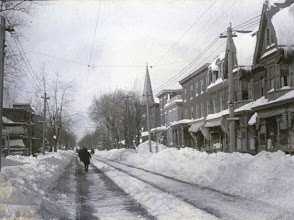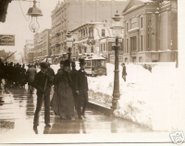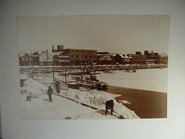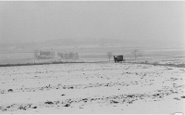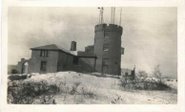Friday, December 22, 2006
Wednesday, December 20, 2006
Implications of Region 3.4/s Latest SSTA - Is el Nino Fading?
This week/s Nino 3.4 region SSTA comes in @ 1.3°C....down 7% from last week.
Is this the beginning of the end? Did it ever get started?
About a year ago...NOAM countries reached consensus on an operational definition for what conditions constitute 'el Nino' and his evil little sister.
"The index is defined as a three-month average of sea surface temperature departures from normal for a critical region of the equatorial Pacific (Niño 3.4 region; 120W-170W, 5N-5S)."
[...]
El Niño: A phenomenon in the equatorial Pacific Ocean characterized by a positive sea surface temperature departure from normal (for the 1971-2000 base period) in the Niño 3.4 region greater than or equal in magnitude to 0.5 degrees C (0.9 degrees Fahrenheit), averaged over three consecutive months."
Nino 3.4 region SSTAs "averaged over three consecutive months" which means there/s a lag built into the calculation. El Nino conditions don/t suddenly appear one day when the SSTA reaches 0.5°C and nor does it fade when an observation falls below the threshold.
The '06 el Nino began toward the end of September when the 12-week SSTA moving average breached 0.5°C. The first observation of an SSTA above the definition/s threshold occurred about six weeks earlier.
The el Nino reached moderate strength (> 1°) with the December 6 observation and continues at the same strength this week...even though the current SSTA declined 7% from last week. In fact...the 12-week moving average rose from 1.01°C to 1.05°C.
Even if the Nino 3.4 region SSTA came in @ 0°C each week for the next two months...el Nino conditions would continue until the first week of February.
How likely is it to see such a sharp drop off of SSTAs? Not very.

Heavy bars bracket Region 3.4
Granted...growth in SSTAs may be slowing or it may simply be evidence of a wave passing through the region. The index has been growing 6 - 9% / week but only 4% with the latest datum. Upstream...in Region 4...SSTAs have held steady @ 1.3°C the past four weeks.
Is it the beginning of the end?
Despite some buzz to the contrary...it/s doubtful. It/ll take some time for the region 3.4/s SSTA to decay.
Did it ever get started?
That seems doubtful...too. At least as far as the planetary flow regime over the CONUS is concerned...although the progs the past few days seem to be coming around to a pattern more representative of +ENSO.
Tuesday, December 19, 2006
Waiting for -AO -- Stratospheric Warming
In some circles...the stratosphere was long known as the 'ignorosphere' in large part b/c all sensible wx was observed in the troposphere so why should anyone care what was going up there.
The stratosphere has been getting a little extra attention recently. Some say there are big changes are afoot that will lead to big changes underfoot.
The phenomenon of 'stratospheric warming' (SW) has been bandied about around MET town of late...along with the strong suggestion that it will induce significant changes in the current planetary flow regime. The change would bring an end the abnormal warmth and snow drought in the E as winter finally gets started.
The PV is currently quite strong...as evidence by the long run of +QBO. Arctic air over the NHEMI is constrained to high latitudes as a result. These synoptic conditions produce positive values for AO and NAO.
When SW over the Pole is observed...the PV is disrupted and its zonal flow weakens. The weakening PV allows arctic air to drain in to lower latitudes.
The time section of 30 mb air temperature shown below has been offered as evidence of an impending stratospheric warming event. Note the warming INVOF the International Date Line (180°W). SW progresses as the warm pool propagates into lower altitudes.
The stratosphere warms...not from warm advection...but from a lowering of the tropopause. Vertical propagation of low numbered Rossby waves are involved but we/re not getting into all that.
- Lower tropopause ==> falling / colder geo-heights
- Lower heights ==> colder air
- Colder air ==> builds hi-lat anticyclone
- Hi-lat anticyclone ==> hi-lat blocking
- Hi-lat blocking ==> -AO
- -AO ==> Trof E
- Trof-E ==> strong outbreaks of arctic air in the E
- Strong outbreaks of arctic air in the E ==> increased chances for storminess
- Increased chances for storminess ==> snowfall forecasting contests
The longitude analysis shown above seems to support that idea; however, the latitudinal time-section of the same data shown below indicates the warming in not occurring over the Pole where it would have to be in order for the AO / NAO sign to flip from positive to negative.

Since the warming is observed INVOF 65°N and not INVOF 90°N...it/s doubtful this warming event will send the AO / NAO below 0.
Sunday, December 17, 2006
Year to Date
You know it/s bad. Maybe so bad you/re afraid to look.
NEWxSFC has 27 stations in play when snowstorms threaten the forecast area. Snowfall year-to-date (YTD) for 24 of these stations (no climo for HYA. NYC is proxy for ISP and JFK) are compared to YTD climo and YTD snowfall from last year.
WARNING: the deficits are large and for Snow Crows...they are depressing.
Granted...December isn/t yet over...but...GooFuS and the rest of that mangy LR NWP crowd still don/t have any good stocking stuffers up their sleeves.
Friday, December 15, 2006
Michaelangelo: The Clock/s Ticking Dude
 The restlessness is palatable and it has the unmistakabe taste of anchovies.
The restlessness is palatable and it has the unmistakabe taste of anchovies.
Will this year end up being another Steinbeck winter of discontent?
If you need a sports metaphor to know where we are at this point...it/s 3rd and 10...10 minutes into the first quarter.
The home team is scoreless and coming to bat in the bottom of the second inning. So what if we boggied the first three holes. Still believe we/ll own the back nine.
Models can tease all they want but the cold air just ain/t there over here. It/s all over there in Uzbekistan...Kyrgystan...Hotdogstan... and Trashcanistan.
Thursday, December 14, 2006
Hey Dude, Where/s My Snow?
Apparently it/s on the other side of the globe where snow has been causing major traffic trubbles of late in Krasnoyarsk...Russia.
Back in the day, Krasnoyarsk was a small part of the vast Union of Soviet Socialist Republics. The Siberian city of ~1x10-6 people is located ~1000 km N of Mongolia and about the same distance NE of Kazakhstan. Other nearby republics once under the thumb of the ol' USSR are Kickstan...Hotdogstan...and Trashcanistan...but I digress.
City authorities report ~300 accidents occurred today...not because of the snowy weather...but because of 'careless drivers' who don/t drive at the 'appropriate speed' given the 'complicated' wx conditions and they/re driving on summer tires with 'worn out protectors.'
Krasnoyarsk/s 'special services' were apparently not up to the task of 'sprinkling the roads' because there was too little special equipment and the 'schedule of snow cleaning and road sprinkling was violated.' Despite the on-going chaos on local highways...the mayor found time to meet with Father Frosts and Snow Maidens to make final preparations for the upcoming New Year celebration.
Despite the on-going chaos on local highways...the mayor found time to meet with Father Frosts and Snow Maidens to make final preparations for the upcoming New Year celebration.
"There will be 38 fir-trees in the yards in Soviet district, the biggest district in Krasnoyarsk. A Local Father Frost noted "there will be plenty of surprises at the main district fir-tree." "
"Sverdlovsky district Father Frost told a lot of residents had been removed from dilapidated accommodation to new apartments in his district in 2006. Apart from that, the water pipe on the Bazaikha River was changed into a new one..."
The city has been named the 'most dynamically developing town' of Russia this year.
As if that wasn/t enough excitement for one day...the city announced a dating agency for animals will sponsor a booth at the upcoming 'New Year Fairy Tale' trade show.
All of which begs the question: can it be harmful to live with too much snow?
Phallacy of Measuring Snowfall
Today...Tornado writes about his perceived fallacy concerning snowfall measurements...maintaining the musical question..."How much snow did you get?"...doesn/t matter one lick b/c all that/s really important is the water equivalent of those billions of frozen hydro-meteors piled up around his house.
To support this crumudgery...he cites as reasons the inherent uncertainty in getting accurate measurements b/c of blowing and drifting...variability of snow:H2O ratios...and a nebulous requirement to take an unspecified number of samples...which are later averaged.
Tornado demands scientific meaning from his atmospheric phenomenon declaring "(s)now depth measurements are arbitrary, inconsistent, misleading and hugely unscientific way to represent fallen winter precipitation."
But that attitude surely misses the point about why snow must be measured with a stick and not a cup.
Can you imagine the headlines on NWS winter storm advisories...watches...and warnings?
"Winter Storm Warning for Pressure Falls...NY
Heavy Snowfall with up to 3/4" Water Equivalent"
Or a second period zone forecast where 'additional snow accumulations between 1/4" to 1/2" water equivalent.
If measuring water equivalent became the standard...what would it do to Schwartz' Admonition? Schwartz found in an observational study conducted during the mid-80s...the amount of observed snowfall was inversely proportional to the excitement at the map wall.
How about a scenario where a principal has to make a decision about whether to close schools b/c of a winter storm based on the expected 'water equivalent?' Mike4Snow can take this one from here.
Arguing the phallacy of snowfall measurements is just being a dick in the mud. If this idea ever comes to pass...just shoot me.
Wednesday, December 13, 2006
PDO - November '06
Woo-hoo! -0.22
The last five months have also been negative but the inter-decadal oscillation of the PDO is revealed by a five-year running average of values for October - March. The cool-season average going into this winter was weakly negative @ -0.15 driven mainly by two month/s of strongly cold values during the fall of '05.

Charting the PDO since 1915 produces a 'smooth' sinusoidal wave where the inter-decadal variability is readily apparent. Apparent that is...until the late '80s / early '90s when the pattern becomes fragmented.
The five-year moving average going into this winter was warm (0.30) as was the preceding year (0.33). The five years prior ('00 - '04) it was negative or just below zero. Going back a few more years further reveals the same weak back-n-forth signature; however, the forays into negative territory were less than one sigma of the mean during the current period...which began in 1980... when values are generally positive.
Despite the recent inter-annual variability...the five-year running average shows we/re in the positive phase of the oscillation.
The historical record of teleconnection indices varies from 1876 for the SOI to 1950 for many others such as QBO...MEI...AO...and NAO. The snowfall period of record varies too...so when evaluating analog years...1950 is usually the earliest.
Whether evaluating the current year/s PDO against the full period beginning in 1900 or only considering years since 1950...the best analog year is 1960...as it was last month.
The problem with '60 is there was a neutral ENSO that winter. All of the Top Five PDO analog years occurred during neutral or cold ENSOs.
So where/s all this analysis take us? Does it reveal anything about the coming winter?
Maybe. Probably not.
Negative phase is correlated with above normal heights over the SE...which is a characteristic of La Nina.
Positive phase finds warm water collecting along the west coast...low SLP over the Aleutian Is. and cold SSTA between 20°N and 60°N. These synoptic features would favor a LW pattern of ridge-W implying +PNA and would complement the fx of +ENSO. +PDO is positively correlated with +ENSO.

5H Z correlations to +PDO similar to +PNA
Temperature and Precipitation correlations to +PDO
show cooler and wetter in the E

SST observed, weekly SSTA, monthly SSTA, and seasonal SSTA
Click to animate. Loop speed = 3 sec / frame
Warm water along west coast - not so much
PDO as a leading indicator seems to be a wash this year. No signature features and all the best analog years are conflicted with the current ENSO phase.
Most graphics and background information from Mantua.
Monday, December 11, 2006
+ENSO Reaches Moderate Strength
Quibblers might claim since the threshold for a moderate event is 'near 1'...the current ENSO reached that point last week when the 12-week moving average was 0.95°C......but this week/s 3.4 anomaly of 1.4°C nudged the number just over the top.
So if we/re on the threshold of a moderate +ENSO...where/s this LW pattern that we expect to accompany these SSTs?
Instead...we have this over NOAM today...
Hold the despair. There are similarities in the planetary flow this year compared to the onset of the last +ENSO.
The previous +ENSO began during the late summer of '04. The region 3.4 anomaly stayed at or slightly above 0.75°C from the fall through mid-winter before fading by early spring.
In the run-up to that winter from 11/1 through 12/9...the mean LW regime over NOAM was...
And this is where we are today for the same period...
Not much difference, eh?
Compare that to the mean 5H Z during the '04 / '05 +ENSO/s MET winter. 
That/s more like it! Ridge-W, Trof-E and split flow across the southern tier.
This strongly suggests we might just have to take our shoes off and sit a spell before the main event gets a'goin'. By the end of Dec '04...the LW pattern had transitioned to one more akin to the 5H composite for +ENSO winters (as shown above).
The snows of '04 were generally near or below period of record normal (PORN) in the Mid-Atlantic and better than PORN across New England.
Keep your snow pants on...it/ll get here when it gets here.
Sunday, December 10, 2006
Eenie Meanie...Chili Beanie - The Spirits Are About To Speak!
Click to animate. Loop speed = 3 sec / frame
Today/s ECMWF progs depict a buckling in the hi-index (zonal) LW flow regime over the PAC early in the forecast period. By D+7...a deep trof b/comes established in the W and a heat ridge bulges over the SE.
Also notable by D+7 is the lowering (rising) 5H heights over the Azores (Greenland) suggestive of a developing hi-lat block.
Given the hi-amp western ridge just upstream of the cold pool in the full-latitude western trof...the upr LOW could retrograde into a 'bowling ball' as the progressive ridge rolls over then aligns near 125W.
Moose: Eenie meanie, chili beanie--the spirits are about to speak!























